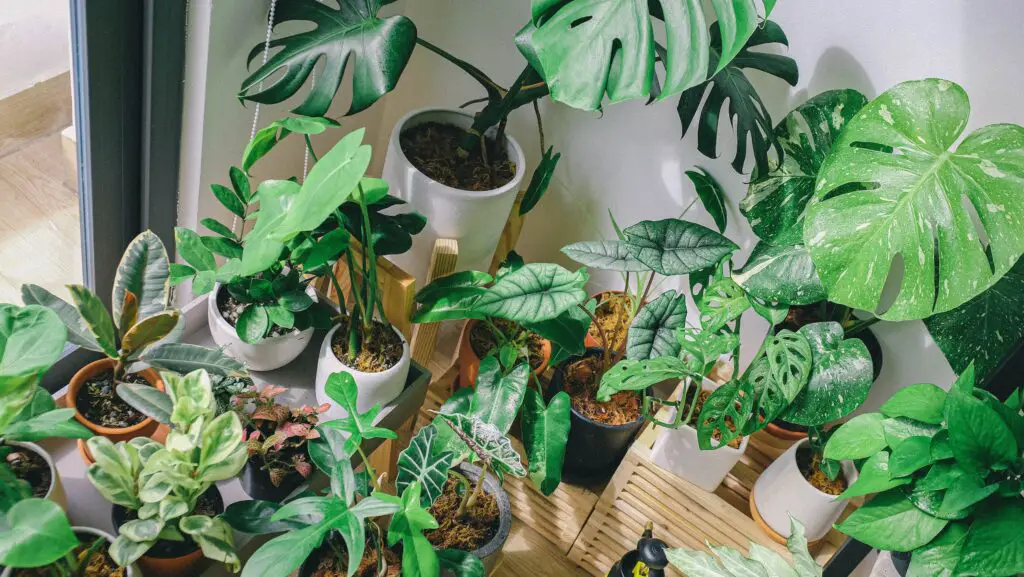Table of Contents
Can a Swiss cheese plant (Monstera deliciosa) grow fruit?
Yes, the Monstera deliciosa can grow fruit under certain conditions. The fruit of the Monstera deliciosa is called a “Monstera fruit” or “Swiss cheese fruit” and is edible when fully ripe.
It is important to note that Monstera deliciosa plants can take several years to mature and produce fruit. The plant requires warm temperatures, high humidity, and bright, indirect light to thrive and produce fruit. It’s also worth noting that not all Monstera deliciosa plants will produce fruit, and even if they do, it may not happen consistently. You will therefore need to ensure plant is healthy and is receiving proper care in order to maximise its chances of producing fruit.


How do you consume Monstera deliciosa fruit?
The Monstera deliciosa fruit can be eaten only when fully ripe and should not be eaten unripe. The unripe fruit is toxic for human consumption. To eat the ripe Monstera deliciosa fruit, you will need to first remove the outer layer of the scales or hexagonal plates that cover the fruit, to reveal its soft, cream-coloured flesh inside. You can remove these scales easily by hand or with a knife.
The fruit has a unique flavour, often described as a mix between pineapple and banana, with a hint of mango. The flavour and texture of the fruit are highly prized in some cultures and is often used in desserts or eaten on its own.

Types of dishes where you can use Monstera deliciosa fruit
The Monstera deliciosa fruit is exotic and delicious addition to a variety of dishes. Monstera deliciosa fruit can be used in various ways such as:
- Fruit salad: The sweet and slightly tangy flavour of the Monstera deliciosa fruit makes it a great addition to fruit salads.
- Smoothies: The creamy texture of the Monstera deliciosa fruit makes it an excellent ingredient for smoothies, especially when combined with other tropical fruits such as pineapple or mango.
- Sorbet: Monstera deliciosa fruit can be pureed and turned into a refreshing and tangy sorbet.
- Cheesecake: Monstera deliciosa fruit can be used to make a unique and flavourful topping for cheesecake.
- Cocktails: The sweet and tropical flavour of the Monstera deliciosa fruit can be used to add a delicious twist to cocktails.
The Monstera deliciosa fruit should only be consumed in moderation, as it contains high levels of oxalic acid. Oxalic acid can be harmful when consumed in large quantities. Additionally, some people may have an allergic reaction to the fruit. It is therefore important to consume a small amount of fruit to test for any adverse reactions before fully consuming it.
Can the Monstera deliciosa grow fruit as an indoor plant?
The Monstera deliciosa can be grown indoors and still produce fruit under the right conditions. However, it’s important to note that growing Monstera deliciosa fruit indoors can be more challenging than growing it outdoors. The plant also requires warm temperatures, high humidity, and bright indirect light to thrive and produce fruit. Even with the right conditions, it can take several years for Monstera deliciosa to mature and produce fruit. Furthermore, not all plants will produce fruit, and may not occur consistently.
What conditions are ideal for growing Monstera deliciosa fruit?
The Monstera deliciosa fruit requires specific conditions to grow and ripen properly. Here are the ideal conditions for growing Monstera deliciosa fruit:
- Temperature: Monstera deliciosa requires warm temperatures between 65-85°F (18-29°C) to grow and produce fruit. Temperatures below 60°F (16°C) can harm the plant and prevent fruit production.
- Humidity: Monstera deliciosa requires high humidity levels to thrive and produce fruit. Humidity levels between 70-80% are ideal. If the humidity is too low, you can increase it by misting the plant with water, placing a humidifier nearby, or using a pebble tray filled with water.
- Light: Monstera deliciosa requires bright, indirect light to grow and produce fruit. Too much direct sunlight can damage the leaves and prevent fruit production.
- Soil: Monstera deliciosa requires well-draining soil that retains moisture but doesn’t become waterlogged. The soil should be rich in organic matter and slightly acidic.
- Fertiliser: Monstera deliciosa requires regular fertilisation during the growing season to provide the necessary nutrients for fruit production. Use a balanced fertiliser every 4-6 weeks.
- Pollination: Monstera deliciosa is pollinated by bees and other insects. If you’re growing the plant indoors, you may need to hand-pollinate the flowers to ensure fruit production.
What types of Montstera deliciosa bear fruit?
There are several cultivars of Monstera deliciosa, including:
- Monstera deliciosa var. Borsigiana: This cultivar is smaller in size than the standard Monstera deliciosa and has slightly different leaf shapes. It’s often favoured by indoor gardeners because of its compact size.
- Monstera deliciosa var. Albo-Variegata: This cultivar has variegated leaves that are white and green. It’s a popular choice among collectors but can be more challenging to grow than other cultivars.
- Monstera deliciosa var. Thai Constellation: This cultivar has leaves that are variegated with white and yellow. It’s a rare and highly sought-after cultivar among Monstera enthusiasts.
Regardless of the cultivar, all Monstera deliciosa plants can potentially produce fruit if they are grown under the right conditions and given enough time to mature.


How do you hand pollinate Monstera deliciosa to produce fruit?
Hand pollination can be a helpful technique to use on Monstera deliciosa to ensure fruit production. Here’s how to hand pollinate Monstera deliciosa:
- Identify the female flowers: Look for flowers that have a small, round swelling at the base. These are the female flowers, and they will eventually produce the fruit.
- Identify the male flowers: Look for flowers that have a long, thin stalk with a yellowish-green pollen sac at the end. These are the male flowers, and they produce the pollen needed for fertilisation.
- Collect the pollen: To collect the pollen, gently tap the pollen sacs with a paintbrush or cotton swab. You can also carefully remove the pollen sacs and transfer them to the female flowers.
- Pollinate the female flowers: Once you have collected the pollen, use the paintbrush or cotton swab to transfer it to the stigma of the female flowers. Be gentle and avoid damaging the flowers.
- Repeat as necessary: You may need to repeat the process several times to ensure adequate pollination and fruit production.
How long does it take for Monstera deliciosa to bear fruit?
Monstera deliciosa plants can take several years to mature and produce fruit, and the time it takes to bear fruit can vary depending on various factors such as growing conditions and cultivar. In general, Monstera deliciosa plants can take anywhere from 4-10 years to produce fruit.
Factors that can influence the time it takes for Monstera deliciosa to bear fruit include:
- Age of the plant: Younger plants may take longer to produce fruit than mature plants.
- Growing conditions: The plant requires specific growing conditions, such as proper temperature, humidity, and soil quality to grow and produce fruit. Suboptimal conditions can delay fruit production.
- Cultivar: Some cultivars may produce fruit earlier or later than others.
- Pollination: If the plant is not properly pollinated, it may not produce fruit.
- Season: Monstera deliciosa plants typically produce fruit during the summer months when temperatures are warmer.
Conclusion
Monstera deliciosa plants have the potential to produce fruit, which is edible and has a unique tropical flavour. It provides a good source of vitamins and minerals. However, Monstera deliciosa plants can take several years to mature and produce fruit. The timeframe that it takes to bear fruit can varies and is highly dependent on various factors, such as growing conditions and cultivar. Hand pollination can be a useful technique to use on Monstera deliciosa to ensure fruit production, as the process involves identifying the female and male flowers and also transferring the pollen from the male flowers to the stigma of the female flowers.
